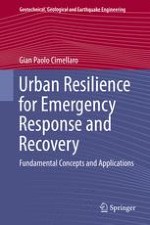2016 | OriginalPaper | Chapter
5. Downtime and Recovery Models
Author : Gian Paolo Cimellaro
Published in: Urban Resilience for Emergency Response and Recovery
Publisher: Springer International Publishing
Activate our intelligent search to find suitable subject content or patents.
Select sections of text to find matching patents with Artificial Intelligence. powered by
Select sections of text to find additional relevant content using AI-assisted search. powered by
